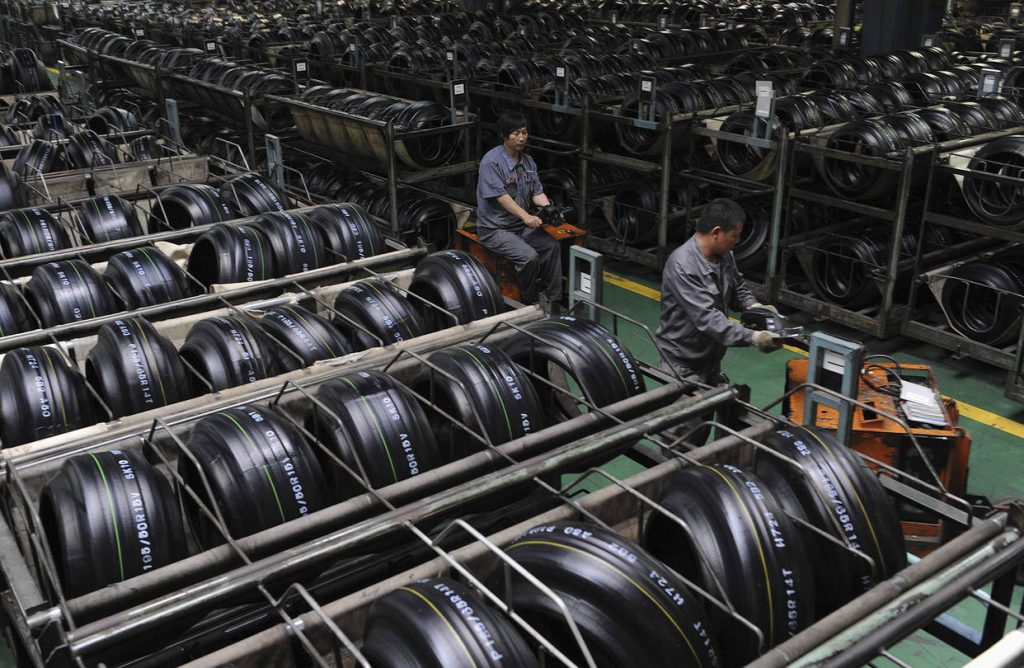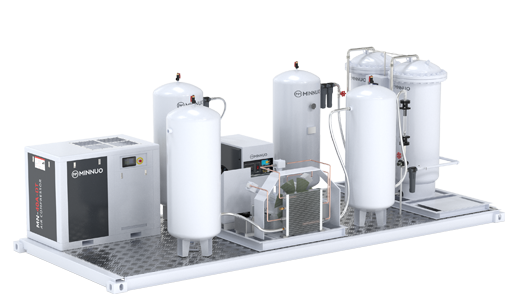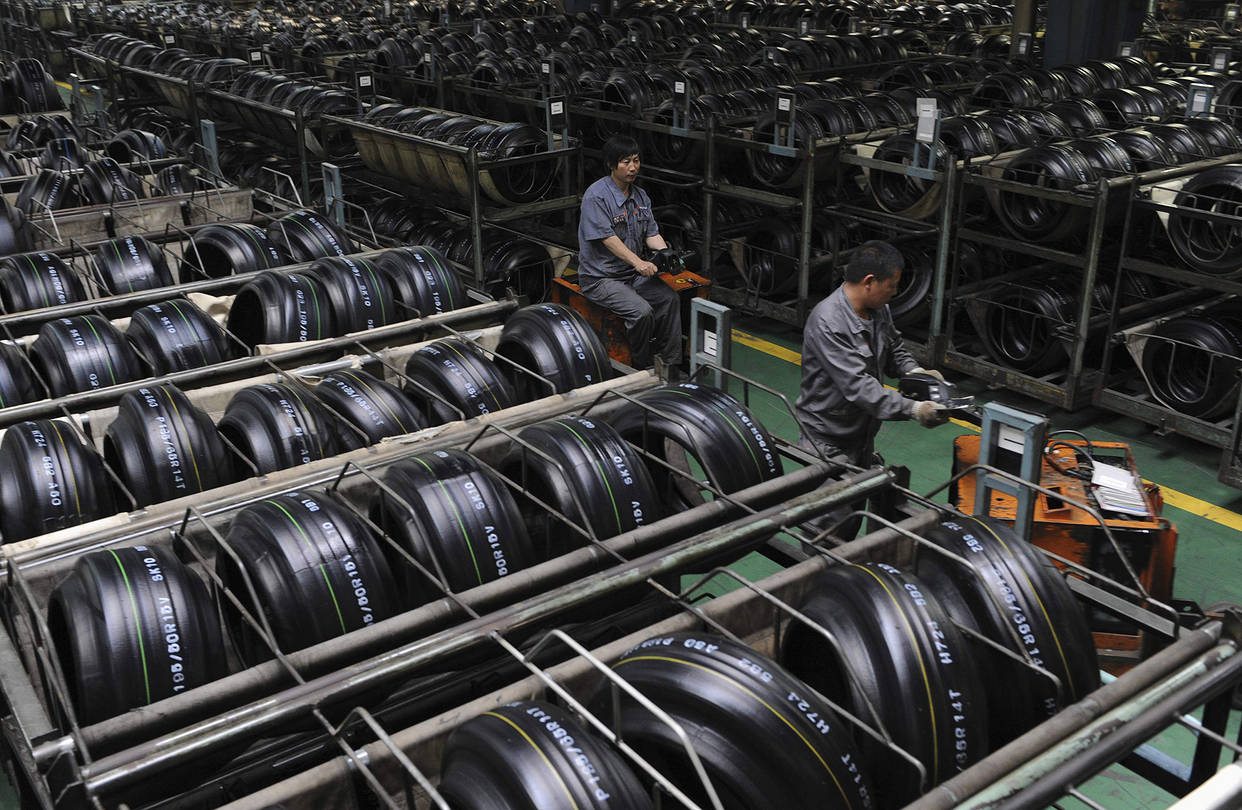I. Core Principle: Nitrogen from Air, Born for Rubber Quality
The core of nitrogen generators dedicated to rubber factories is the efficient separation of nitrogen from air. Two mature mainstream technologies are adopted to adapt to different production scenarios:
- Pressure Swing Adsorption (PSA) Technology: Utilizes the adsorption difference of carbon molecular sieves (CMS) for oxygen and nitrogen to achieve continuous separation through pressure switching. It can produce high-purity nitrogen with a purity of 95%-99.999%, suitable for medium and large production lines and high-purity demand scenarios (such as high-performance tire and special rubber production).
- Membrane Separation Technology: Retains nitrogen through the difference in permeation rates of polymer membranes, while discharging oxygen and water vapor. It produces nitrogen with a purity of 95%-99.5%, featuring a compact equipment structure and lower energy consumption, ideal for small and medium-sized factories and ordinary rubber product production.
Both technologies realize “on-site nitrogen generation and on-demand supply”, completely replacing traditional cylinder gas supply and solving pain points such as high transportation costs, unstable gas supply, and significant safety hazards.

II. Core Functions: Nitrogen as the “Quality Guardian” and “Safety Shield” in Rubber Production
As an inert gas, nitrogen plays a role throughout the entire rubber production process, directly determining product quality and production safety:
- Anti-Oxidation to Protect Quality: In links such as rubber polymerization (nitrile rubber, butyl rubber, etc.), vulcanization, drying, and packaging, nitrogen can displace air (oxygen), avoiding oxidative degradation of rubber materials and additives due to high temperatures, ensuring the elasticity, strength, and service life of products, and reducing the defect rate.
- Stabilize Processes to Improve Precision: During vulcanization, nitrogen forms a stable positive pressure environment, allowing rubber products to be evenly pressed, avoiding defects such as bubbles and lack of glue; at the same time, it assists in temperature control to ensure uniform vulcanization reaction and improve product dimensional consistency.
- Anti-Corrosion to Extend Service Life: Nitrogen purging of molds can reduce oxidative carbon deposition and extend mold service life; it protects raw materials such as rubber monomers (e.g., butadiene) and vulcanizing agents in storage tanks from deterioration and polymerization.
- Explosion-Proof to Ensure Safety: Reduces the concentration of volatile gases in the vulcanization workshop to meet explosion-proof standards; can be used for fire fighting in emergency situations, building a solid safety line for production.
III. Key Parameter Requirements: Precise Matching is the Premise for Efficient Production
Rubber factories have clear requirements for the purity, cleanliness, flow rate, and pressure of nitrogen from nitrogen generators, and accurate selection must be based on process scenarios:
| Parameter Type | Core Requirements | Corresponding Application Scenarios |
|---|---|---|
| Nitrogen Purity | 95%-99.999% (selected on demand) | – Ordinary rubber products (hoses, seals): 95%-99%- Tire vulcanization/conventional polymerization: 99%-99.5%- Special rubber (nitrile, butyl) polymerization: 99.9%-99.99%- Laboratory analysis: 99.999%-99.9999% (ultra-high purity) |
| Cleanliness | Dew point ≤ -40℃, oil content < 0.01ppm, no dust or impurities | Avoid moisture and oil contamination of rubber raw materials, prevent molecular sieve clogging, and ensure stable equipment operation |
| Flow Rate Requirement | 5-100+ Nm³/h (single equipment) | – Small production lines/laboratories: 5-20 Nm³/h- Medium-sized vulcanization workshops: 20-50 Nm³/h- Large tire factories/continuous production: 50-100+ Nm³/h (supports multi-unit linkage) |
| Pressure Requirement | 4-10 barg (adjustable) | Adapt to the pressure requirements of equipment such as vulcanizers and polymerization kettles, ensure uniform nitrogen penetration, and pressure fluctuation ≤ ±0.1 barg |
IV. Scientific Selection Guide: Choosing the Right Nitrogen Generator = Cost Reduction + Quality Improvement + Safety
- First Determine Process Requirements: Clarify the core gas usage scenarios (such as vulcanization, polymerization, storage), and select models based on the purity/flow rate of the main scenarios — prioritize PSA nitrogen generators for high-purity needs (such as special rubber), and membrane separation nitrogen generators for ordinary scenarios to balance cost and efficiency.
- Match Production Scale: Reserve flow redundancy at “maximum hourly gas consumption × 1.2” to avoid insufficient gas supply; recommend modular equipment for medium and large factories to support capacity expansion and upgrading.
- Focus on Safety Performance: For vulcanization workshops, select explosion-proof nitrogen generators that meet ATEX Zone 2 or GB3836 standards, equipped with explosion-proof motors and anti-static design, suitable for high-temperature and high-dust environments (protection level ≥ IP65).
- Calculate Energy Consumption Costs: Prioritize energy-saving models with energy consumption ≤ 0.5 kWh/Nm³. Replacing cylinders with “on-site nitrogen generation” can reduce nitrogen usage costs by 30%-50%, and the investment can be recovered in 12-24 months.
- Evaluate Manufacturer Strength: Choose manufacturers with core technologies (such as molecular sieve optimization, intelligent control systems), localized after-sales services (24-hour response), and rich cases (such as Minnuo Group) to avoid production disruptions due to equipment failures.
V. Daily Use and Maintenance: Key to Extending Service Life + Stabilizing Efficiency
(I) Daily Usage Specifications
- Parameter Monitoring: Record nitrogen purity, flow rate, and pressure data daily. When purity decreases by 0.5% or gas production decreases by 10%, promptly troubleshoot faults (such as reduced molecular sieve adsorption efficiency).
- Environmental Adaptation: Install the equipment in a well-ventilated and dry place, avoiding high temperatures (>40℃) and humid environments; install a pre-positioned high-efficiency filter if there is excessive dust in the workshop.
- Operating Procedures: Purge pipelines before starting the machine, and displace the internal parts of the equipment with nitrogen before shutting down to prevent impurity residue; do not disassemble pipelines while the equipment is running.
(II) Regular Maintenance Points (Focus of Engineers)
| Maintenance Cycle | Core Content | Notes |
|---|---|---|
| Daily | Drain condensed water from the air storage tank; check if pressure gauges and flow meters display normally | Increase drainage frequency in coastal areas (once every 3 days) |
| Weekly | Clean dust on the equipment surface and radiator; test the sensitivity of the automatic drainer | Wipe with neutral detergent to avoid corrosion of the shell |
| Monthly | Calibrate instruments (error ≤ ±5%); check solenoid valve response speed (≤ 2 seconds) | Replace malfunctioning instruments and maintain valve tightness |
| Quarterly | Rinse the heat sink of the refrigerated dryer; calibrate the nitrogen analyzer (error ≤ ±0.1%) | Improve heat exchange efficiency and ensure accurate purity detection |
| Annual | Conduct pipeline air tightness test (leakage rate < 0.1%); replace activated carbon filters | Inspect joint leaks and reduce energy loss |
| 2-3 Years | Replace molecular sieves of PSA nitrogen generators; check the performance of membrane separation components | Avoid purity reduction due to aging of core components |
VI. Optimized Application Solutions: Making Nitrogen Generators a “Tool” for Cost Reduction and Efficiency Improvement
- Intelligent Linkage Upgrade: Link nitrogen generators with vulcanizers and polymerization kettles through PLC systems to automatically adjust nitrogen flow rate and pressure according to production load, reducing ineffective energy consumption and improving process matching.
- Waste Heat Recovery and Utilization: Utilize the high-temperature environment of the vulcanization workshop (membrane separation nitrogen generators have higher efficiency at high temperatures) or recover waste heat from nitrogen generator compressors for workshop heating and raw material preheating, achieving energy savings of 10%-30%.
- Graded Gas Supply Design: For multi-scenario gas demand in factories (such as high-purity polymerization + low-purity storage), adopt the “main unit nitrogen generation + graded purification” scheme to avoid waste of high-purity nitrogen and reduce operating costs.
- Remote Monitoring and Operation and Maintenance: Equipped with Minnuo Group’s intelligent monitoring system to real-time monitor equipment operation status and early warn of faults; support remote diagnosis to reduce downtime.

VII. Market Development Strategy: Accurately Meeting the Core Needs of Rubber Enterprises
- Focus on Segmented Scenarios: Focus on breaking through three major fields: tire manufacturing, special rubber (nitrile, butyl), and seals/hoses, and launch customized solutions for different scenarios (such as large-flow PSA nitrogen generators for tire factories, membrane separation nitrogen generators for small and medium-sized seal factories).
- Pain Point Marketing Entry: Take “replacing cylinders to reduce costs”, “anti-oxidation to improve quality”, and “explosion-proof to ensure safety” as core selling points, and produce case comparison manuals (such as a tire factory that reduced the defect rate by 15% and saved 200,000 yuan annually after using Minnuo nitrogen generators).
- Channel Cooperation Expansion: Establish cooperation with rubber vulcanization equipment manufacturers and chemical raw material suppliers to bundle sales of nitrogen generators; participate in rubber industry exhibitions (such as China Rubber Technology Exhibition) to demonstrate equipment performance on site.
- Value-Added Services to Attract Customers: Provide free gas volume calculation and process matching scheme design; launch “lease-to-own” and “operation and maintenance outsourcing” services to reduce investment thresholds for small and medium-sized enterprises; promise 24-hour on-site maintenance to solve after-sales concerns.
Minnuo Group: A Preferred Partner for Nitrogen Generators in Rubber Factories
With years of experience in the industrial nitrogen generation field, Minnuo Group‘s dedicated nitrogen generators for the rubber industry have three core advantages: ① Strong technical adaptability: Dual technical routes of PSA/membrane separation to meet the full purity demand of 95%-99.999%; ② Excellent safety performance: Explosion-proof design + IP65 protection, suitable for complex environments of rubber workshops; ③ High cost controllability: Energy consumption as low as 0.3 kWh/Nm³, combined with an intelligent operation and maintenance system to reduce the whole-life cycle cost.
From selection consultation to installation and commissioning, from daily maintenance to technical upgrading, Minnuo Group provides “one-stop” services to help rubber enterprises achieve high-quality, low-energy-consumption, and safe production. Contact us now to get an exclusive nitrogen generation solution!





 sales2:+86 17506119168
sales2:+86 17506119168

